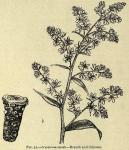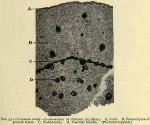 The dried rhizome and roots of Vera'trum vir'ide Aiton (American).
The dried rhizome and roots of Vera'trum vir'ide Aiton (American).
BOTANICAL CHARACTERISTICS.—Roots fibrous; stem 2 to 7 feet high, stout and very leafy, somewhat pubescent. Leaves broadly oval, clasping. Flowers in dense panicles, yellowish-green. Capsule many-seeded.
HABITAT.—North America and Europe.
 DESCRIPTION OF DRUG.—Usually in small pieces or large slices. When entire, obconical, from 50 to 75 mm. (2 to 3 in.) long, truncate at the base, tufted above with the inert stem-remnants and leaf-stalks, and beset on all sides with light yellowish-brown rootlets about the thickness of a knitting needle; externally blackish. A transverse section shows a dingy white surface dotted with darker colored dots and wavy lines within the nucleus sheath. The larger part of the tissue consists of parenchyma containing starch and calcium oxalate; nucleus sheath wavy, wood-bundles numerous. Rootlets have a thick, cortical parenchyma. Inodorous; taste bitter, very acrid, causing a tingling, benumbing sensation in the tongue. The powder is sternutatory. Starch grains of Veratrum, see Fig. 283.
DESCRIPTION OF DRUG.—Usually in small pieces or large slices. When entire, obconical, from 50 to 75 mm. (2 to 3 in.) long, truncate at the base, tufted above with the inert stem-remnants and leaf-stalks, and beset on all sides with light yellowish-brown rootlets about the thickness of a knitting needle; externally blackish. A transverse section shows a dingy white surface dotted with darker colored dots and wavy lines within the nucleus sheath. The larger part of the tissue consists of parenchyma containing starch and calcium oxalate; nucleus sheath wavy, wood-bundles numerous. Rootlets have a thick, cortical parenchyma. Inodorous; taste bitter, very acrid, causing a tingling, benumbing sensation in the tongue. The powder is sternutatory. Starch grains of Veratrum, see Fig. 283.
Powder.—Characteristic elements: See Part iv, Chap. I, B.
CONSTITUENTS.—Veratrum viride contains the alkaloids jervine, C26H37NO3 (to which the depressant action on the circulation is partly due) and protoveratrine, C32H51NO11. This, the most important of the Veratrum alkaloids, occurs in colorless shining crystals, belonging to the monoclinic system, which are permanent in air and melt at 245° to 250°. Insoluble in water, benzene and petroleum benzin, and dissolves with difficulty in most other solvents. Chloroform and boiling 96 per cent. alcohol are its best solvents. Its alcoholic solution rapidly changes red litmus to blue. It forms a greenish colored solution with concentrated H2SO4 which gradually changes to blue and finally to violet.
If dissolved in diluted alcohol, it will usually be obtained in the form of a colored syrupy residue upon evaporation of the solvent, only a small portion crystallizing.
Jervine is a depressant to the respiratory center, to the vasomotor center and to the heart muscles.
Rubijervine stimulates the cardio-inhibitory centers, but appears to depress the respiratory center.
There is no physiological relationship between protoveratrine and veratrine. The latter is the active principle of ASAGRAEA officinalis, (61).
ACTION AND USES.—The action of veratrum viride closely resembles that of aconite, being a powerful cardiac depressant and spinal paralyzant, but in addition it has a strong emetocathartic action, and consequently overdoses are less likely to prove fatal; death occurs by paralysis of the heart. Dose: 1 to 5 gr. (0.065 to 0.3 Gm.).
- OFFICIAL PREPARATIONS.
- Tinctura Veratri Viridis (10 per cent.), Dose: 1 to 5 drops (0.065 to 0.3 mil).
- Fluidextractum Veratri Viridis Dose: 1 to 5 drops (0.065 to 0.3 mil).

